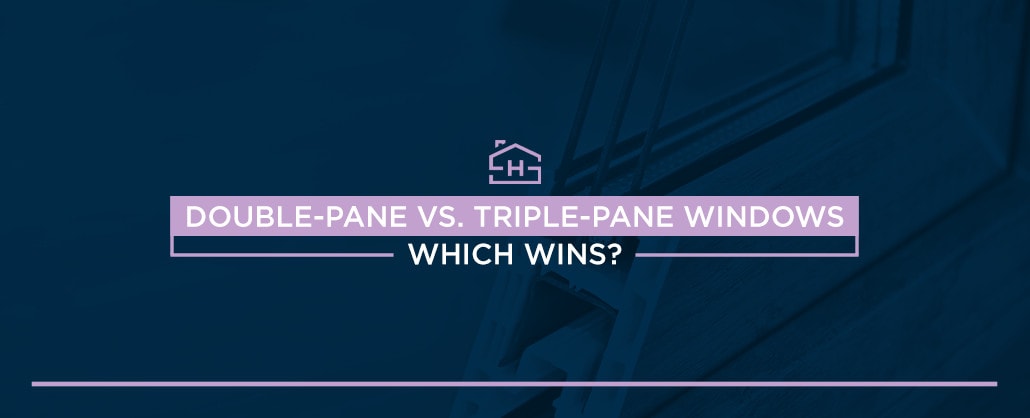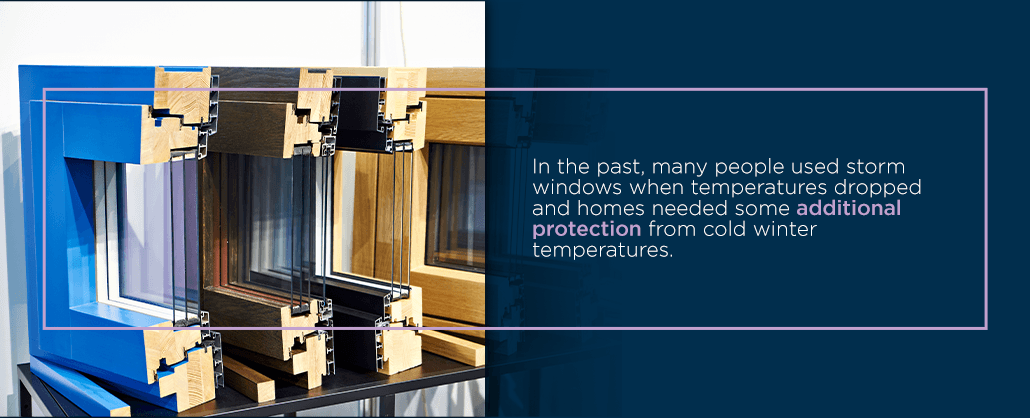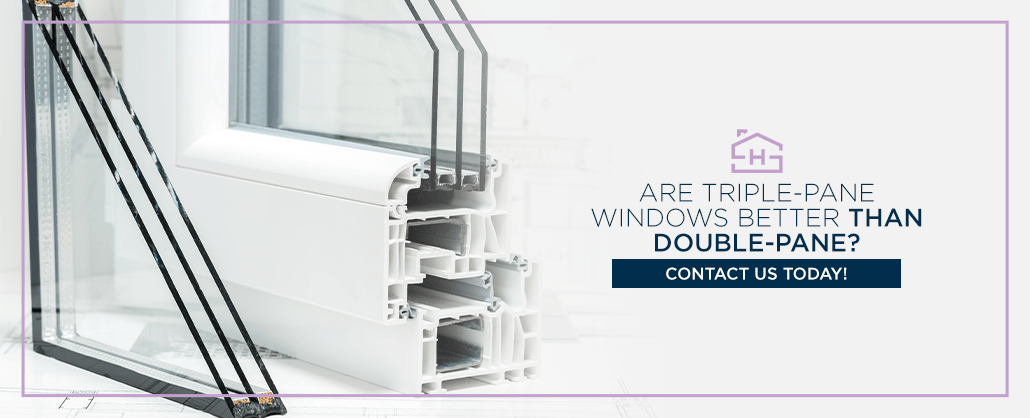Replacing old or broken windows is one of the best investments you can make as a homeowner. While it may not seem as glamorous as renovating the kitchen or painting the walls, new windows can provide significant savings on monthly energy costs, as well as a 72% return on investment if you eventually sell your home.
There’s been a lot of talk about making houses more energy-efficient — and with good reason. Investing in energy-efficient windows, doors and, other features is an environmentally friendly way to design and maintain a home. It’s about more than just recycling. It’s also about sustainable manufacturing practices and reducing your house’s environmental footprint by lightening the burden on HVAC systems. Opting for energy-efficient products also saves you money and keeps your family more comfortable inside your home.
Why do you need energy-efficient windows?
Heat gain and loss through windows is responsible for nearly 30% of all the energy your house uses regularly. If your windows are preventing your home’s interior from remaining at a consistent temperature throughout the year, you’re probably feeling the pinch in your wallet too.
Double- and triple-pane windows are two energy-efficient options available today. Both of these windows are known for preventing heat loss, reducing the burden on a house’s HVAC system, and contributing to lower monthly energy costs.
But which one is better? And what should you consider for your own home?
What Are Double- and Triple-Pane Windows?
Traditionally, windows were created using one sheet of glass framed with wood or vinyl. But even the best of these windows couldn’t prevent heat loss inside the house or maximize energy efficiency.
In the past, many people used storm windows when temperatures dropped and homes needed some additional protection from cold winter temperatures. Storm windows are an extra window installed over the primary window in the fall and stayed in place — protecting against wind and snow — until the warmer temperatures of spring arrive.
Although storm windows are still an option, window technology has come a long way and now incorporates the concept of a storm window — multiple panes of glass — into one window.
A double-pane window is composed of two parallel panes of glass. In between the two panes of glass is an insulating gas, typically krypton or argon. When a window has multiple panes of glass, it does a better job of preventing heat loss inside of the house in the winter or allowing heat to come into the house from the outdoors in the summertime. Double-pane windows significantly improve a home’s overall energy efficiency — and therefore, lower energy costs.
Similarly, a triple-pane window is composed of three parallel panes of glass, with insulating gas in between each panel. Like their double-pane cousins, these windows provide higher energy efficiency because they keep warm air inside in the winter and outside in the summertime.
While both of these windows are sure to provide improved energy efficiency to just about any house, there is an ongoing debate over which one is the best option. While triple-pane windows can often be the most energy-efficient option, upgrading to these windows — often considered a luxury item — is very expensive and might not make sense for your home.
If a Double-Pane Window Works, What Would Make A Triple-Pane Window Better?
Double-pane windows can reduce noise, prevent heat loss, and lower energy costs. But so can triple-pane windows. So what makes triple-pane windows stand out in the crowd?
1. Noise Reduction
There’s a lot to be said for peace and quiet in the middle of a city’s hustle and bustle. The three layers of glass can be a great barrier between your home and any noise outside. If you live in an urban area that’s prone to a lot of noise, such as traffic, airplanes, or loud neighbors, springing for triple-pane windows can go a long way toward keeping your house quiet and peaceful inside. Double-pane windows can also reduce noise, but the extra layer of glass in triple-pane windows can turn your home into an oasis.
2. Prevents Heat Loss
Window convection is the scientific term for what happens when the air around a window gives up its heat to the glass and the cold air that’s left sinks to the floor. In single-pane windows, this can become so intense that some people mistake convection for a draft, especially in areas prone to extreme cold. A triple-pane window has three layers of glass, as well as the insulating gas between each layer, to act as a barrier to warm air, preventing it from being drawn through the glass and leaving the room.
In other words, the multiple layers of triple-pane windows keep warm air exactly where it needs to stay, ensuring your family stays warm and comfortable during the cold winter months.
3. Low-E Coating
Low-E — low emissivity — glass has a special coating applied to it to prevent the heat from sunlight from entering your home. The purpose of Low-E glass is to add additional energy efficiency to a window. Combining this coating with the triple-layers of glass and insulating gas makes it the most energy-efficient option on the market and takes it beyond the insulating ability of a double-pane window, especially one that hasn’t been coated with Low-E.
Although triple-pane windows have some advantages, they aren’t always the best option when it’s time to replace the windows in your house. Here are three factors to consider:
- Weight: The layers of gas and krypton — which often fills triple-pane windows — aren’t light. These windows are incredibly heavy and may require some modifications to your house’s structure to support their weight properly.
- High Cost: Triple-pane windows are often a luxury window, so they do cost more upfront. Besides the costs of extra glass and the expense of krypton, there will be additional costs if your home has to be modified to support the weight of the windows.
- Energy savings vary: If you’re upgrading the windows in your forever home, then you’ll likely be there long enough to recoup some of the costs associated with triple-pane windows. Over time, you can save a significant amount of money in energy costs. However, if you aren’t planning to stay in your house for at least 10 years, then the differences in efficiency between double- and triple-pane windows aren’t always substantial enough to justify the difference in initial costs.
Is Upgrading From a Double-Pane Window to a Triple-Pane Window Worth It?
Are triple-pane windows better?
Unfortunately, there isn’t one simple answer to this question. In some cases, triple-pane windows will add value to a home and provide additional savings on energy bills over the years. But, in other cases, a high-quality double-pane window can provide just as much protection and savings. At Homespire, our 12-layer glass system allows us to offer the efficiency of a triple-pane window at the cost of a double-pane window. The 12-layer system can save homeowners up to 35% on monthly energy costs because they’ll help increase your house’s energy efficiency by as much as 54%.
Here are some things to think about as you decide if it’s worth the jump from a double-pane to the triple-pane window.
1. Climate
If you live in an area prone to long, harsh winters, then triple-pane windows can provide outstanding protection from the elements. These windows will keep the warm air inside where it belongs and the brutally cold air outside. And, since triple-pane windows are known for their noise reduction capabilities, those howling winter winds won’t keep you awake at night either.
2. You Are in Your Forever Home
If you plan to stay in your home long-term, then triple-pane windows can provide years of comfortable living, and you’ll enjoy long-term savings on energy costs. As you learn more about triple-pane windows, you may find conflicting information about the cost differences between double- and triple-pane windows.
3. You’re Upgrading Your Home’s Efficiency
Triple-pane windows coated with Low-E are the most efficient windows you can buy today. If you’re pulling out all the stops to make your home as energy efficient as possible, then these top-of-the-line windows are the way to go.
Is It Time to Upgrade Your Windows?
If you’re unsure whether it’s time to upgrade and replace your existing windows, here are a few factors to consider.
1. You’re Using Single-Pane Windows
If your home currently has single-pane windows, especially older ones, then it’s definitely time for an upgrade! Replacing single-pane windows with double- or triple-pane windows will keep your house at a more comfortable temperature and will likely save you money on energy bills.
But before you sign on the dotted line, take some time to investigate. If you live in an older home, don’t automatically assume that your windows are single-pane. You could spend a lot of money on windows that didn’t need to be replaced. Schedule a visit with a representative from an experienced window installation company to determine what kind of windows you have.
2. It’s Difficult to Keep a Steady Temperature in the House
Do you find yourself bumping up the heater throughout the day? Are you sleeping in a hat and socks to stay warm in the winter? Your windows may be to blame. If you have single-pane windows, the colder outdoor temperatures will find their way inside, and some of the heat from your heating system is likely disappearing through the glass.
Likewise, if you are sweating even with the AC running full blast and downing frosty glasses of ice water to keep comfortable in the summertime, it might be time to upgrade to double- or triple-pane windows with a Low-E coating. Besides keeping cooler air indoors where it belongs, windows with a Low-E coating repel the heat from sunlight, preventing more of that heat from making its way through your windows and into your home during the summer.
When a house’s windows aren’t efficient, the HVAC system ends up working overtime. If you’ve noticed your HVAC running longer or more frequently than it should, inefficient windows may be the culprit.
3. Your Window Glass Keeps Fogging Up
Single-pane window glass easily absorbs the cold temperatures outside. When the cold glass comes into contact with the warm interior of your home, those windows will collect condensation on them. This can also happen when it’s humid or rainy outside. Double- and triple-pane windows are designed to maintain a more even temperature and repel humidity, keeping the glass clear.
Older or cheaper double-pane windows can become foggy between the panes if the seal breaks. When the seal brakes, outside air drifts in between the panes of glass and condenses, causing foggy patches that are impossible to get rid of.
4. Your Windows Are Broken or Damaged
Broken or damaged windows can be a serious safety concern, especially if you have young children in your home. Someone can get cut on the broken glass or an intruder may use that window to gain access to your home when you aren’t there. In some cases, minor damage can be repaired, but if the damage is extensive or found on multiple windows, it may be a sign that it’s time to replace the windows.
Most of today’s windows are framed in vinyl, but older windows have wood frames that must be maintained to avoid damage. Discolored or soft spots on a wooden window frame may be a sign that it’s time to replace them.
Are Triple-Pane Windows Better Than Double-Pane?
The double-pane vs. triple-pane window debate continues. Triple-pane windows are a high-quality product that can successfully complement today’s energy-efficient houses. They provide the best in insulation and offer energy savings that can really pay off in the long term, making them a great option for homes in areas that see extreme temperatures. But double-pane windows can provide many of the same benefits at a lower cost.
Infinity from Marvin’s windows are specially designed for the challenges… of the Mid-Atlantic region’s unique climate. Because we’re a hands-on facility, we design our products to provide our customers with high-quality craftsmanship on windows that will keep them comfortable year-round. Our windows come with a warranty because… we strongly believe our products are that good. And, since our W-2 employees install the windows, we’ll guarantee our work with a warranty on labor too.
If you’re in the market to purchase new windows, contact Homespire for a free window analysis today.
Get 20% Off
PLUS
No Deposit, No Payments, and No Interest for 12 Months*
*By completing the form, I consent to have Homespire Windows and its affiliates contact me to verify my information, schedule an appointment, or inform me of future product updates, which may include marketing. I consent to receive calls or texts that use automated technology or a pre-recorded voice at the phone number(s) provided. Consent is not required to receive goods and services. I can call the phone number found at the top of this web page. Please see our Terms & Conditions. Msg & data rates may apply.




